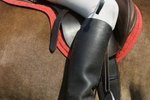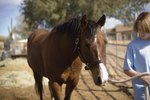
Western riding is more than herding cattle and badlands chases. Modern Western riding entails several types of performance, show and pleasure riding. For each type of Western riding, there is a saddle that benefits both the horse and the rider.
Performance
Western riders who show their horses in performance events, such as barrel racing, cutting, reining and roping, use saddles with certain specifications that help keep the rider safe in fast-paced events. For instance, a barrel saddle has a deep, rough seat, and high cantle and horn, to aid the rider's balance. Cutting and reining saddles have flatter seats than the barrel saddle and lower cantles; but they also have high horns. The Western roping saddle has a deep seat and a thick, strong horn for moving cattle on the end of a rope.
Pleasure
When riding in the pleasure showing ring or on the trail at a slower pace, a rider generally opts for the lighter, more compact Western pleasure saddle. This saddle often comes with tooling or “bling” when used for show. The balance point is in the rear of the saddle and provides a more relaxed ride for the horse and the rider. Horns and cantles come in various sizes to fit individual riders' needs and preferences.
Training
A Western training saddle generally comes with a reining seat, flat and padded and allowing for hip movement. Several D rings are often attached to a training saddle for a horse trainer to take advantage of training aids such as a martingale. Training saddles often have fenders of rough letter for better grip and cut-out skirts for better rider-to-horse contact.
All-Around
For the all-around rider, finding one type of saddle is often difficult. An all-around saddle has a flat seat made from a wooden "tree" covered with suede. The skirting has close contact so the horse feels the rider’s cues easily. The all-around saddle generally has a high horn for added grip and reinforced rigging for roping.
References
Resources
Photo Credits
-
Dick Luria/Photodisc/Getty Images
Writer Bio
Amanda Maddox began writing professionally in 2007. Her work appears on various websites focusing on topics about medical billing, coding, real estate, insurance, accounting and business. Maddox has her insurance and real estate licenses and holds an Associate of Applied Science in accounting and business administration from Wallace State Community College.



